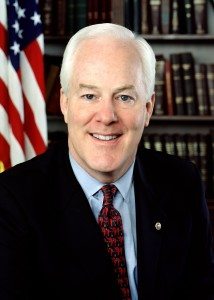 WASHINGTON—U.S. Senator John Cornyn (R-TX) and U.S. Congresswoman Sheila Jackson Lee (TX-18) have partnered on the Emancipation National Historic Trail Study Act, a bill to provide for the study of the Emancipation National Historic Trail, a 51-mile route from the Osterman Building and Reedy Chapel in Galveston to Freedmen’s Town and Emancipation Park in Houston. Sen. Cornyn introduced the bill today in the U.S. Senate, and Rep. Jackson Lee’s version passed the U.S. House of Representatives in May.
WASHINGTON—U.S. Senator John Cornyn (R-TX) and U.S. Congresswoman Sheila Jackson Lee (TX-18) have partnered on the Emancipation National Historic Trail Study Act, a bill to provide for the study of the Emancipation National Historic Trail, a 51-mile route from the Osterman Building and Reedy Chapel in Galveston to Freedmen’s Town and Emancipation Park in Houston. Sen. Cornyn introduced the bill today in the U.S. Senate, and Rep. Jackson Lee’s version passed the U.S. House of Representatives in May.
“Upon receiving the monumental emancipation announcement we celebrate each year on Juneteenth, newly freed slaves travelled from Galveston to Houston to share with their fellow Texans that all who had been enslaved were now free,” said Sen. Cornyn. “Officially marking their route as the Emancipation National Historic Trail will commemorate that life-altering trek and preserve history for generations to come.”
“I thank Senator Cornyn for introducing this historic companion legislation in the United States Senate,” said Rep. Jackson Lee. “In the 115th Congress, I first introduced H.R. 434 and began the journey of establishing a trail commemorating the Emancipation Trail. At the beginning of the 116th Congress, that journey began anew, and the work continued to have passed only the second trail commemorating the African American experience. The establishment of the Emancipation Trail would run over 51 miles and the start of the trail would be located where General Gordon Granger rode into Galveston, Texas, on June 19, 1865, to announce the freedom of the last American slaves. His announcement belatedly freed 250,000 slaves nearly two and a half years after Abraham Lincoln’s Emancipation Proclamation. The enslaved Africans – now newly freed – traveled from Galveston to spread the news to neighboring communities, who otherwise did not learn of the news through the Emancipation Proclamation. And, beyond the vital need to preserve this important heritage, there are also economic reasons to establish this trail. Trails and national monuments bring jobs, tourism dollars and talent, in the form of personnel and entrepreneurs. According to the National Park Service, spending in communities in national parks resulted in a $40.1 billion benefit to the nation’s economy and supported 329,000 jobs. And, according to statistics compiled by Headwaters Economics, land management analysts, the establishment of a national park or a trail such as the one proposed by my legislation yields many economic benefits. These statistics posit that trends in important economic indicators either continued or improved in regions surrounding certain national monuments. Moreover, for per capita income, it shows that this measurement improved for all of the counties studied, which are proximate to national monuments and trails. Of particular note for optimism is the rise in personal wealth of those living in and around areas with these parks and places, a significant leading indicator, “particularly in rural areas where earnings per job are often declining.”
###
Libby Hambleton Sharp
Texas Press Secretary
U.S. Senator John Cornyn (R-TX)

